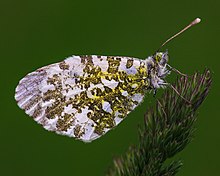Anthocharis cardamines
| Orange tip | |
|---|---|
 |
|
| Male, Oxfordshire | |
 |
|
| Female, Rosenfeld, Germany | |
| Scientific classification | |
| Kingdom: | Animalia |
| Phylum: | Arthropoda |
| Class: | Insecta |
| Order: | Lepidoptera |
| Family: | Pieridae |
| Tribe: | Anthocharini |
| Genus: | Anthocharis |
| Species: | A. cardamines |
| Binomial name | |
|
Anthocharis cardamines (Linnaeus, 1758) |
|
| Subspecies | |
|
See text. |
|
See text.
Anthocharis cardamines, the orange tip, is a butterfly in the family Pieridae.
The common name derives from the bright orange tips of the male's forewings. The males are a common sight in spring, flying along hedgerows and damp meadows in search of the more reclusive female which lacks the orange and is often mistaken for one of the other 'white' butterflies. The undersides are mottled green and white and create a superb camouflage when settled on flowerheads such as cow parsley and garlic mustard (Alliaria petiolata). The male is able to hide his orange tips by tucking the forewings behind the hindwings at rest. On close examination of the mottling, the green colour can be seen to be made up of a mixture of black and yellow scales. The butterfly is found across Europe, and eastwards into temperate Asia as far as Japan. The past 30 years have seen a rapid increase in the range of the orange tip in the UK, particularly in Scotland and Ireland, probably in response to climate change.
The female lays eggs singly on the flowerheads of cuckooflower (Cardamine pratensis) and garlic mustard (Alliaria petiolata) and many other species of wild crucifers, all of which contain substances called glucosinolates. Females are attracted to larger flowers, such as Hesperis matronalis, even though some such species are poor larval hosts. Selection of foodplants is triggered by the presence of mustard oils and their derivative glucosinolates, which (in Pierinae) are detected by chemosensory hairs on the fore-legs. Reproductive rate of females appears to be limited by difficulties in finding suitable hosts. As a consequence, the species has evolved to use a wide range of crucifers.
The eggs are white to begin with but change to a bright orange after a few days before darkening off just before hatching. Because the larvae feed almost exclusively on the flowers and developing seedpods there is rarely enough food to support more than one larva per plant. If two larvae meet one will often be eaten by the other to eliminate its competitor. Newly hatched larvae will also eat unhatched eggs for the same reason. To stop eggs from being laid on plants already laid on the female leaves a pheromone to deter future females from laying. There are five larval instars. The green and white caterpillar is attacked by several natural enemies (notably tachinid flies and braconid wasps).
...
Wikipedia
